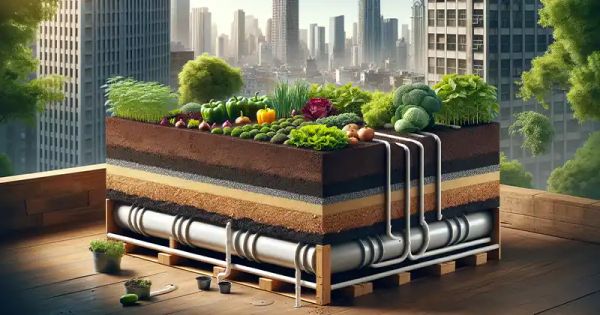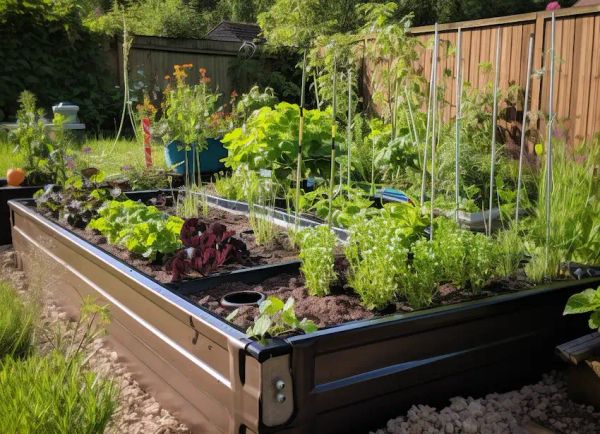In cities where green spaces are scarce and concrete dominates, the wicking bed shines as a beacon of sustainability, transforming small areas into vibrant, productive gardens. Not only does it offer an innovative way to garden in urban environments, but it also champions wise water usage in the battle against drought and wastefulness.

The Wicking Bed: A Clever Solution
A wicking bed is essentially a self-watering raised garden. It is designed to utilize water efficiently by allowing plants to draw moisture up from a built-in reservoir, reducing the need for frequent watering. This clever system works through capillary action – the same concept that enables a paper towel to soak up a spill. In the setup we’re discussing, the system features an ‘L’-shaped pipe that evenly distributes water across the bed’s length and extends above the soil for easy monitoring and refilling of water levels.
Crafting Your Own Garden Marvel
To create a wicking bed similar to the one shown in the photo you provided, follow these instructions to ensure proper functioning of the water distribution system:
Select the Right Container: Start with a sturdy container that can hold a substantial amount of soil and has space for a water reservoir underneath. A custom wooden frame, an old bathtub, or a repurposed large planter are all great options for your wicking bed base.
Seal the Deal: Line the chosen container with a high-quality waterproof membrane to create the water reservoir. Make sure it’s completely sealed to prevent any leaks.
Install the ‘L’-Shaped Pipe: Lay a PVC pipe along the bed’s length on top of the aggregate. The pipe should have perforations along the horizontal section to allow for even water distribution. At one end, it bends upwards, extending above the bed’s height to serve as the fill point.
Add a Layer of Aggregate: Fill the bottom of the container with a layer of coarse aggregate, such as gravel, and level it. This is where your water will be stored.
Use Geotextile Barrier: Cover the aggregate and the horizontal section of the pipe with a geotextile fabric. This will prevent soil from washing into the reservoir while allowing water to wick upwards.
Add Soil: Pour a nutrient-rich soil mix on top of the fabric. The soil should be suitable for the specific plants you want to grow, be it vegetables, herbs, or flowers.
Ensure Overflow Outlet: Install an overflow valve or pipe at the level where the soil meets the aggregate. This is crucial to prevent waterlogging by allowing excess water to escape.
Plant and Mulch: Plant your seeds or seedlings into the bed and cover the surface with organic mulch to minimize evaporation.
Water and Observe: Fill the reservoir through the vertical pipe until water starts to overflow. Then, sit back and watch as your plants draw water from below, flourishing with minimal maintenance.
Creating a wicking bed like this is a significant step towards self-sufficiency and resilience in urban gardening. By embracing this method, you are committing to a sustainable future where resource conservation and green living thrive in our cities. 




